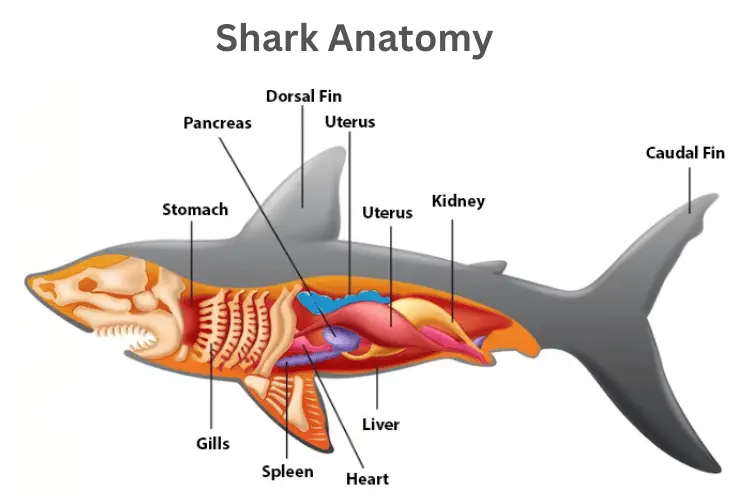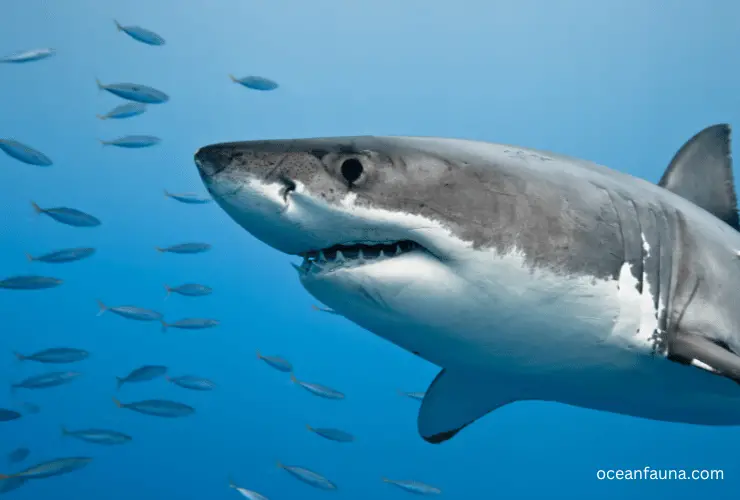People are often confused, thinking that sharks have two hearts.
But sharks have just one heart, which is divided into two chambers. The ventral aorta carries oxygen-rich blood from the heart to the gills and the rest of the body, while the dorsal aorta returns deoxygenated blood back to the heart.
In this article, I will delve deeper into the circulatory system and explore the anatomy of their hearts.
Anatomy of a Shark’s Heart
The anatomy of a shark’s heart is composed of two chambers, the atrium and the ventricle. The larger chamber atrium receives oxygen-depleted blood from the organs and body tissues. The ventricle is the smaller chamber that pumps oxygen-rich blood to the gills for re-oxygenation before it circulates back to the rest of the body.

The heart also has four valves: two atrioventricular (AV) valves, one tricuspid valve, and one pulmonary valve. The tricuspid valve separates the chambers while allowing only the unidirectional flow of blood into and out of the heart’s ventricle.
The AV valves are located in between each atrium and ventricle to prevent backflow during contraction. Finally, a single pulmonary valve connects to a separate artery that sends oxygenated blood directly to the gills without ever entering the heart chamber first.
The walls of both chambers contain muscles that help to generate pressure on either side. This pressure helps push blood through semi-lunar valves within veins as well as arteries, keeping it flowing in one direction throughout the circulation.
Additionally, a conus arteriosus lies at the base of a shark’s heart, pumping blood from the left ventricle with force toward other organs to adequately function and carry out their metabolic processes.
Why Do Sharks Have a Two-Chambered Heart?
Sharks have a two-chambered heart because it is better adapted to their lifestyle and environment. It helps sharks to maintain a fast, sustained swimming speed of up to 25 mph by continuously cycling oxygenated blood through their bodies. Because they’re constantly in motion, having a two-chambered heart allows them to efficiently cycle oxygenated blood throughout their bodies.

It also prevents them from becoming exhausted quickly due to overworking their hearts by pumping too much oxygenated or deoxygenated blood around their bodies.
Furthermore, this particular arrangement enables sharks to regulate temperature more effectively than most other fish species due to its ability to differentiate between warm and cold water temperatures as it pumps blood around its body.
Doing so can reduce heat loss from warm parts of the body when swimming in colder waters and vice versa. Ultimately, this helps keep the shark’s muscles working efficiently for longer periods without expending too much energy trying to regulate its body temperature.
How Do Sharks’ Hearts Differ from Humans’ Hearts?
Heart Chambers
One of the major differences between a shark’s heart and a human’s heart is the number of chambers. A shark’s heart has two chambers—an auricle and a ventricle—whereas a human’s heart has four chambers—two atria and two ventricles.
The presence of two extra chambers in humans compared to sharks gives their hearts a larger capacity, allowing them to efficiently pump more blood than sharks can.
Oxygen Intake
Another key difference between a shark’s heart and a human’s heart is how they breathe oxygen. Sharks use gills to extract oxygen from the surrounding water, whereas humans extract oxygen through their lungs.
This difference is due to the fact that humans have evolved to breathe air while most aquatic species, such as sharks, still rely on water for oxygen intake.
Blood Flow
Sharks and humans have remarkably divergent circulatory systems. In human beings, blood is carried via both veins and arteries to the heart, whereas sharks experience direct circulation from their gills straight into their systemic flow. This makes it easier for sharks to sustain uniformity of blood distribution while they are resting or sleeping – conserving their energy when inactive.
Heartbeat
The final difference between sharks’ hearts and humans’ hearts is their respective heartbeat rates. Humans typically have higher resting heartbeat rates than sharks.
On average, humans have a resting heartbeat rate between 60-100 beats per minute (bpm), while sharks typically range from 8 bpm to 12 bpm.
However, during intense physical activity or periods of stress, human rates may increase up to twice as much as that of a shark.
This difference allows sharks more efficient energy expenditure during times of increased activity while also allowing them some protection against sudden surges of adrenalin that could potentially overwhelm their circulatory system if they had similar heartbeat rates as humans do.
Are There Any Similarities Between Sharks’ Hearts And Humans’ Hearts?
There is very little similarity in performance between the hearts of sharks and humans. Both rely on a circulatory system to supply oxygenated blood to the body, and both have muscular walls that expand and contract to pump blood throughout their bodies. Sharks and humans also have valves in their hearts, which control the flow of blood within each chamber.

However, the number of chambers in shark hearts (two) is much smaller than the number of chambers in human hearts (four), and there are differences in size and shape as well.
Additionally, sharks lack a pulmonary circuit as humans do. Instead, their two-chambered heart pumps less-oxygenated blood directly out to their gills for re-oxygenation. Thus, while there are some similarities between sharks’ hearts and humans’ hearts, there are many more differences between them.
Can Sharks Get a Heart Attack?
Yes, sharks can get heart attacks. Despite their tough exterior, sharks are susceptible to certain health issues, including heart problems. This is because even though a shark’s skin acts as a natural defence against many viruses and bacteria, it does not protect them from the effects of fear and stress.
A blacktip reef shark in a Russian zoo was removed from public view after it suffered what appeared to be a “nervous breakdown” and eventually died of a heart attack. Post-mortem results later confirmed the presence of cardiac disease, suggesting that this particular species is at risk for developing heart-related issues.
The exact causes of these conditions remain unknown but could include genetic predisposition, environmental factors, or lifestyle choices. To mitigate risk, experts advise keeping sharks in healthy environments with reduced stress levels as well as ensuring they receive adequate nutrition and exercise.
Conclusion
Hopefully, you have a compact knowledge of a shark’s heart and how it performs. Unlike a human, it has a two-chambered heart, which allows it to pump less-oxygenated blood directly out to its gills for re-oxygenation. So, sharks can rely on water for oxygen intake. Despite having natural immunity to many illnesses, sharks are still prone to health issues such as heart complications caused by stress and fear. Their environment must be kept healthy to ensure they stay in good condition. This includes providing them with a low-stress atmosphere, proper nutrition, and exercise.

